Stored Product Insects
A large number of different species compose the SPI. Damage is caused by larval and adult stages of beetles and mites and generally by the larval stages only of moths. The insects can survive for long periods of time on minute residues of food in cracks in the building fabric thereby constituting an important source of reinfestation.
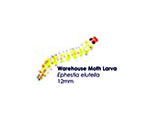
Warehouse Moths
Warehouse Moths are a major pest of warehouses and more recently retail premises. Infestations are especially serious where wheat and flour are stored in bulk.
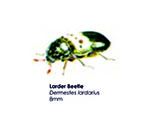
Larder Beetle
Damage is caused by the Larder Beetle larvae which bore holes in materials, either as they feed or in order to pupate. The soft sapwood of wooden structures are preferred pupation sites.
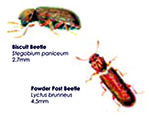
Biscuit Beetles
Biscuit Beetles are a pest of cereal products. There have been reports of it infesting poisonous substances such as strychnine belladonna and aconite. The larvae causes damage to packaging and products and can burrow through solid materials such as tin foil and sheet lead.

Grain Weevil
Grain and hard cereal damage by Grain Weevil include larvae feeding, dusty excretia causing tainting and heating up of the grain, accelerating development of the insect, making the commodity liable to caking, moulding and even germination.

Confused Flour Beetles
Confused Flour Beetles are generally recognised as secondary pests, causing flour to become prone to moulding and they taint commodities with secretions from scent glands.
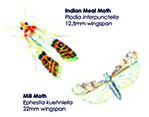
Indian Meal Moths
Indian Meal Moths are a problem of the fruit-drying industry, also attacking cereals, oil seeds and shelled nuts. Larval webbing may occasionally reach problem proportions.
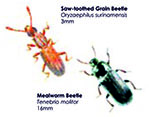
Saw Toothed Grain Beetle
Saw Toothed Grain Beetle infest cereal products, dried fruit, dried meats, oilseeds, nuts, rice and even drugs. The germ may be damaged leading to grain caking, moulding and even sprouting.
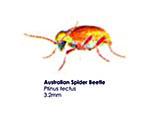
Australian Spider Beetle
Australian Spider Beetle larvae infest all manner of dry animal and vegetable matter. The larvae bore holes in which to pupate, and in doing so may damage packaging or the commodities themselves. They also contaminate commodities with droppings and silk webbings, and are commonly associated with the bird’s nests from which it may invade food premises.

